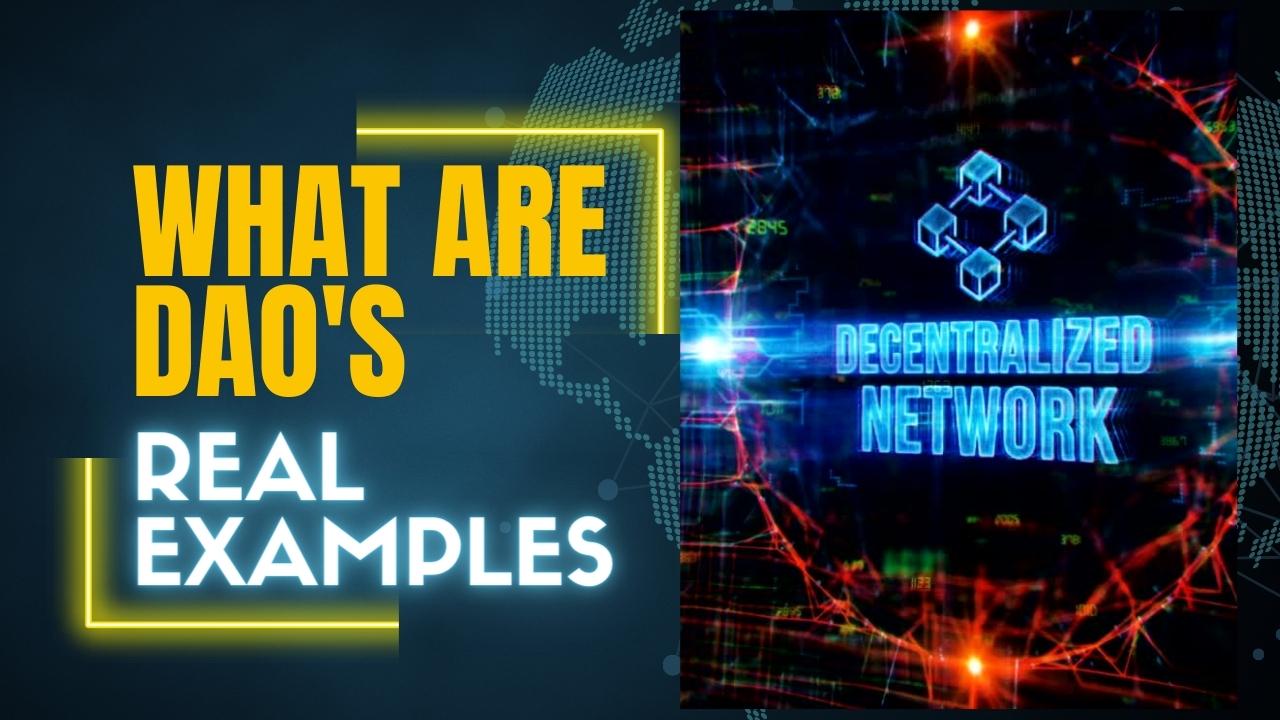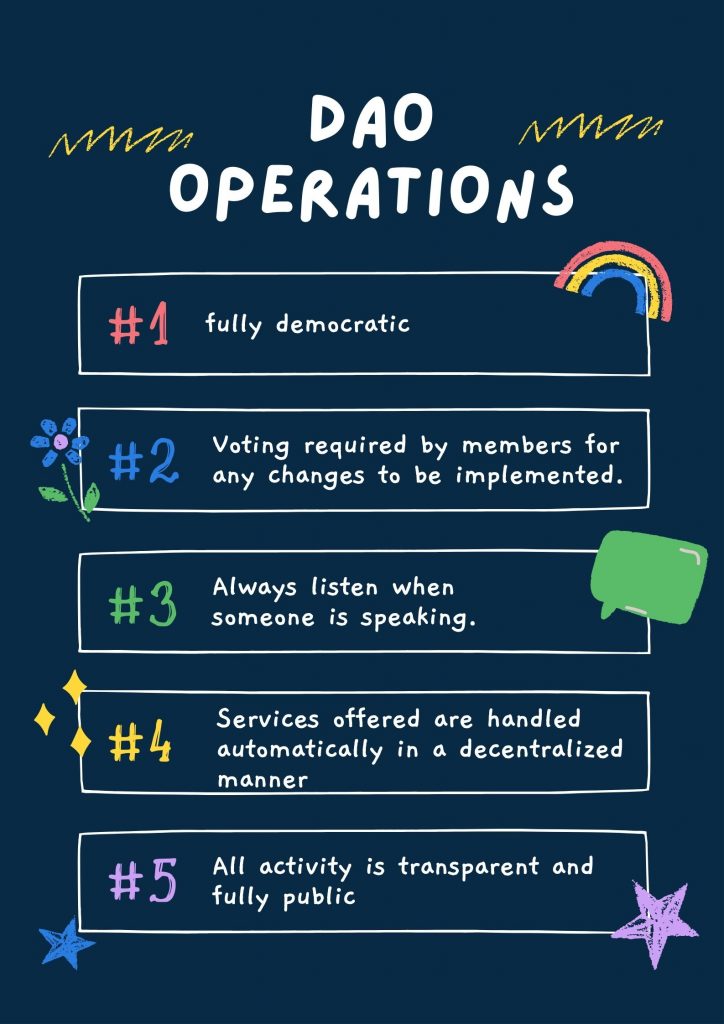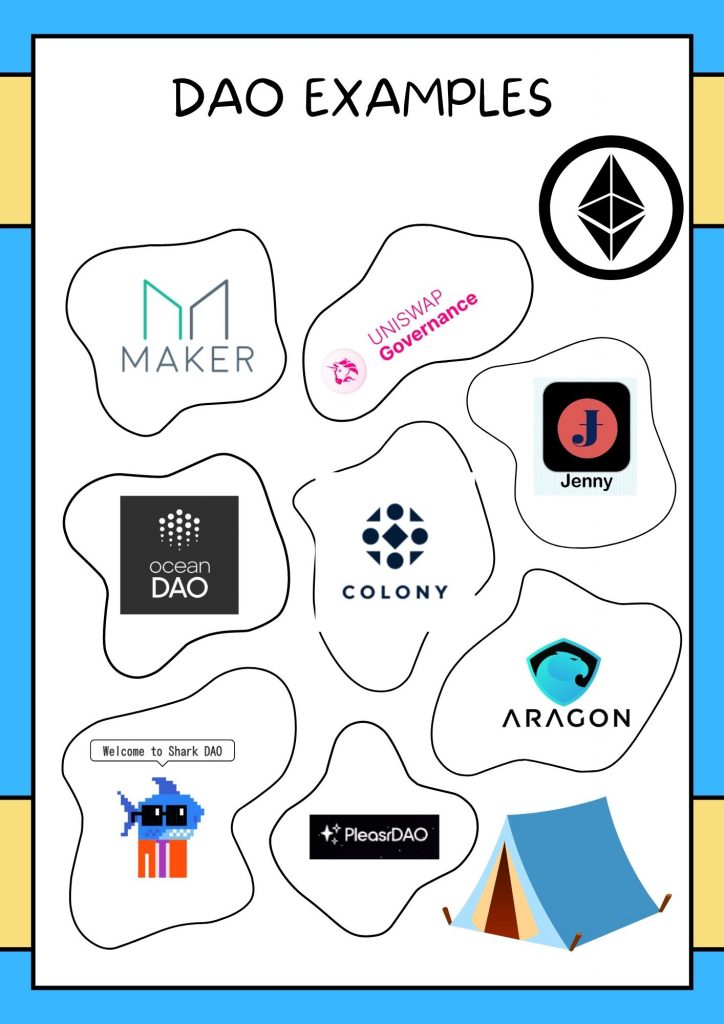
Table of Contents
What is a DAO (Decentralized Autonomous Organizations) on Web 3.0
DAO stands for Decentralized Autonomous Organization. A DAO is an organization that is automated and not controlled by any singular entity. It’s governed by rules and computer code. So, everything is transparent and equally managed by organization members. Each member is given a token that represents shares of the DAO, and that token can be used to vote in the DAO to make decisions. Any member can submit a proposal, and anyone else can vote on that proposal. This is especially useful for things like fundraising, where everyone can vote on what to release the funds for, and then they can literally watch the transactions going in and out on the blockchain. So everything is transparent, and everyone in the organization knows that the money was used for what it was supposed to be used for.
Bitcoin is generally considered to be the first fully working DAO because it’s a fully running operational protocol, without the need for one person or an entity controlling it. It’s been over 10 years and Bitcoin continues to function autonomously. DAOs rely on smart contracts, which are collections of code that run on a blockchain and control all actions inside a DAO.
Why we need DAOs?
In a traditional structure, there’s typically a hierarchy that looks something like a pyramid. There’s a board of directors, executives, or upper management. And these are the key decision-makers. And those are the bottom of the pyramid really don’t have much power to make changes or to propose new ideas. On the other hand, all members of a DAO can vote on decisions together. DAO rules are built by a core team of community members through the use of smart contracts. And these smart contracts lay out the framework from which the DAO is to operate. These are visible, verifiable and publicly auditable, so anyone can fully understand how the DAO works. And when joining a DAO, you agree to the code that’s in place, it isn’t easy to change the code. And it typically requires votes between all the members. To obtain voting power or membership you are typically required to buy governance tokens, which are cryptocurrencies or digital assets tied to certain projects, think of these as tokens, or voting chips that really enable you to vote on key decisions that could take place inside the DAO.
DAOs are mostly created with the following objectives:-
- Collecting charities for various objectives.
- Ventures and grants for investments in various projects.
- Collecting NFTs, digital arts with joint investments.
How a DAO actually works?
DAOs are based on smart contracts which govern the complete organisation. Once the smart contract gets live on blockchain link Ethereum, no one can change the rules of the organisation himself. Any change requires a complete vote in a DAO to be implemented. Similarly, the money a DAO owns is controlled by all and can be spent only by a vote.
Another advantage of a DAO is transparency. Smart contracts are open and everyone can see the rules. So, there is no hidden agenda involved.
Any member of a DAO can put a proposal about the operation of the protocol or regarding any finances involved which is put to a community vote to be accepted or rejected.

What are the Cons of DAO in Web 3.0?
DAOs seem like a modern and streamlined approach to operating a business. But there are some inherent issues with DAOs. Some of the DAOs have proven to be pure DAO Ponzi schemes and scams. Similarly, decentralized governance may not work in every scenario.
Legal Issues
All of the laws around businesses and their corporate structures really are not made to fit into the decentralized organizations. There isn’t one clear CEO or founder which makes it really difficult to hold someone accountable If things do go wrong. There’s still a really big debate on just how to protect those that use DAOs and regulations surrounding DAOs. They’re still unfolding.
DAO Types
Each DAO is structured a little differently but the majority of them fall into one of the following categories.
1. DAO Operating Systems
They offer the resources for people to start their own DAO.
2. Grant DAOs
These are communities that are built around to donate funds. They use DAOs to vote on How the capital is allocated to various purposes with the consensus of all members.
3. Protocol DAOs
These are the most common DAOs and are focused on giving voting power back to the community. The tokens are used to vote on and also implement changes. DAOs use smart contract protocols to bring decentralised financial services to users
4. Investment DAO
Investment Dows allow members to collect investments for projects in the early stages.
5. Social DAOs
These are made to replicate social networks where friends can become co-workers and can really interact on a decentralised platform.
6. Working DAOs
These are used to create decentralised working groups for individuals and also talent agencies. So as more and more blockchain companies come into the market, this helps to bridge the gap between the talents and the communities
7. Collector DAOs
These DAOs work to acquire NFTs based on long term value.
8. Content creator DAOs
They incentivize content creators and consumers with a reward ecosystem. They also share an open agenda of decentralized news.

DAO Examples (Real-world Decentralized Organisations)
Uniswap
Uniswap is currently the biggest DAO which is a decentralized finance platform. . It has over 275,000 members and a USD value of approximately 2.9 billion. The uniswap token is currently the 20th biggest in market cap. There are hundreds of tokens linked to this autonomous business model.
Jenny DAO
Jenny DAO holds one of the largest NFT collections. The DAO members collectively vote on which NFTs to acquire and discuss the things in exclusive chat channels.
Shark DAO
It is a DAO that began with a group of strangers that came together to acquire Nouns, which is a type of NFTs. Since their establishment, they have acquired 5 nouns.
Constitutional DAO
It is one of the most interesting DAO. The constitutional DAO came very close to buy the US constitution with a crowdfunded $46 million bid in 2021. It signifies the ability of DAOs to rally thousands of people together towards achieving one goal.
Bankless DAO
The DAO is focused on spreading knowledge about web 3.0 with content.
Future of DAO (Decentralized Autonomous Organizations)
The state of Wyoming became the first state to legally recognize DAOs and grant them the same rights as a limited liability company LLC. More and more states are going to recognize Companies working on decentralized principles. The future of corporations could be really different as DAOs take on legacy businesses. People are looking to go decentralized as the idea has grabbed the attention of people. We may see completely different organizational setups as people take the power of decisions back to the grass root levels from executives. However, everything is not good for DAOs. There are still some unresolved issues with DAOs that must be kept in mind while joining a DAO.
FAQ
Which is the biggest DAO in the real world?
Uniswap is the biggest DAO in Web 3.0. It is a decentralized crypto exchange with more than 275,000 members.
How decisions are taken in a DAO?
Every decision is put to a vote and is decided by a majority vote.
What are the objectives of a DAO in Web 3.0?
A DAO is created as a decentralized platform where money can be collected centrally for charity, projects, investments and is controlled by everyone with a vote.
How to create a DAO quickly?
You can create a DAO quickly with DAO creation platforms like Aragon or Moralis.
Disclaimer
The Post is only the views of the author and should not be taken as legal or financial advice.